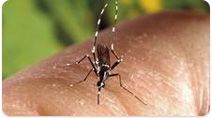
ECDC has published a new Rapid Risk Assessment on the first case of chikungunya, a mosquito-borne viral disease, reported in Spain with no travel history to endemic areas. The patient developed symptoms on 7 July while travelling in France, had no history of travel outside the EU during at least three months, and was most likely infected in the city of Gandía, Valencia community in Spain.
The report of an autochthonous case of chikungunya in Spain is not unexpected. The competent vector, Aedes albopictus mosquito, has been present in Valencia since 2013, and imported cases of chikungunya have been reported from the city of Gandía where the climate is conducive to chikungunya transmission.
Europe is vulnerable to autochthonous transmission of chikungunya virus in areas where mosquitoes capable of carrying the disease are established and where climate is conducive to chikungunya transmission. The risk of onward transmission in Europe is linked to imported cases from chikungunya-endemic areas elsewhere in the world.
The current world-wide epidemiological situation of chikungunya has resulted in an increased number of imported chikungunya cases in Europe, mainly originating from the Americas. Travellers returning from chikungunya outbreak areas should seek medical care if presenting with symptoms consistent with chikungunya. This allows reducing the risk of viral introduction to the European mosquito population and limiting the establishment of a local cycle of transmission during the summer season.
Exposure to infected mosquitoes is the principal risk for infection in currently affected areas. Prevention of chikungunya is based on vector control and personal protection against mosquito bites.
ECDC assessment reminds of the importance of capacity to detect possible cases in areas with presence of the competent vectors, strengthened surveillance systems, including laboratory capacity, education and collaboration of the general public on how to control mosquito breeding sites, rapid implementation of vector control measures, and other aspects of preparedness regarding chikungunya in the EU.